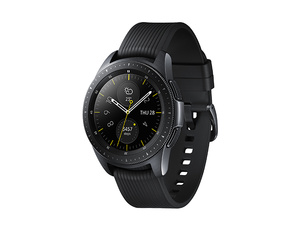 Samsung has revealed the new Galaxy Watch with LTE connectivity, long-lasting battery life and a bunch of Health and Productivity focused elements.
Samsung has revealed the new Galaxy Watch with LTE connectivity, long-lasting battery life and a bunch of Health and Productivity focused elements.
The new Galaxy Watch is LTE connected, supported across 30+ carriers and 15+ countries, meaning it can be untethered from a smartphone and deliver messaging, mapping, music and calls. Two separate sizes are available; 42mm and 46mm. The former is available in Midnight Black or Rose Gold, while the latter is available only in Silver.
Another key difference between the options is the battery. The smaller 42mm option packs a 270mAh battery delivering approximately 45 hours on a full charge with typical use or up to 120 hours with low usage. Meanwhile, the 46mm option has a larger 472mAh battery for up to 80 hours per charge with typical usage, or as much as 168 hours with low usage.
Samsung's Galaxy Watch sports a 1.3-inch, Circular Super AMOLED (360 x 360), Full Color Always On Display, protected by Corning Gorilla Glass. There will be over 60,000 faces available for the Galaxy Watch. A daily briefing feature will sync your Calendar and show your appointments on the home screen.
There is a strong focus on Health tracking with the Galaxy Watch too. A new stress management tracker, which automatically detects high levels of stress and offers breathing exercises to help keep users centered and focused. Additionally, a new advanced sleep tracker monitors all levels of sleep, including REM cycles, to help users adjust sleeping habits.
A total of 39 workouts can also be tracked as can your calorie intake with the help of Bixby Vision on their Galaxy device. Users can track their meals and log nutritional information in Samsung Health and on Galaxy Watch for better calorie management.
Samsung promises a seamless experience with SmartThings, Samsung Health, Samsung Flow, Samsung Knox, Samsung Pay, Bixby and with partnerships like Spotify and Under Armour.
So when will it be available and what will it cost? In the United States, the Galaxy Watch will launch on August 24, the same day as the new Galaxy Note 9. A 42mm model will set you back $330 while the larger 46mm model will cost $350. Outside of the U.S., the Galaxy Watch is confirmed to land in Korea on August 31, 2018, and in additional select markets on September 14, 2018.
Another key difference between the options is the battery. The smaller 42mm option packs a 270mAh battery delivering approximately 45 hours on a full charge with typical use or up to 120 hours with low usage. Meanwhile, the 46mm option has a larger 472mAh battery for up to 80 hours per charge with typical usage, or as much as 168 hours with low usage.
Samsung's Galaxy Watch sports a 1.3-inch, Circular Super AMOLED (360 x 360), Full Color Always On Display, protected by Corning Gorilla Glass. There will be over 60,000 faces available for the Galaxy Watch. A daily briefing feature will sync your Calendar and show your appointments on the home screen.
There is a strong focus on Health tracking with the Galaxy Watch too. A new stress management tracker, which automatically detects high levels of stress and offers breathing exercises to help keep users centered and focused. Additionally, a new advanced sleep tracker monitors all levels of sleep, including REM cycles, to help users adjust sleeping habits.
A total of 39 workouts can also be tracked as can your calorie intake with the help of Bixby Vision on their Galaxy device. Users can track their meals and log nutritional information in Samsung Health and on Galaxy Watch for better calorie management.
Samsung promises a seamless experience with SmartThings, Samsung Health, Samsung Flow, Samsung Knox, Samsung Pay, Bixby and with partnerships like Spotify and Under Armour.
So when will it be available and what will it cost? In the United States, the Galaxy Watch will launch on August 24, the same day as the new Galaxy Note 9. A 42mm model will set you back $330 while the larger 46mm model will cost $350. Outside of the U.S., the Galaxy Watch is confirmed to land in Korea on August 31, 2018, and in additional select markets on September 14, 2018.
Tags:
Samsung













